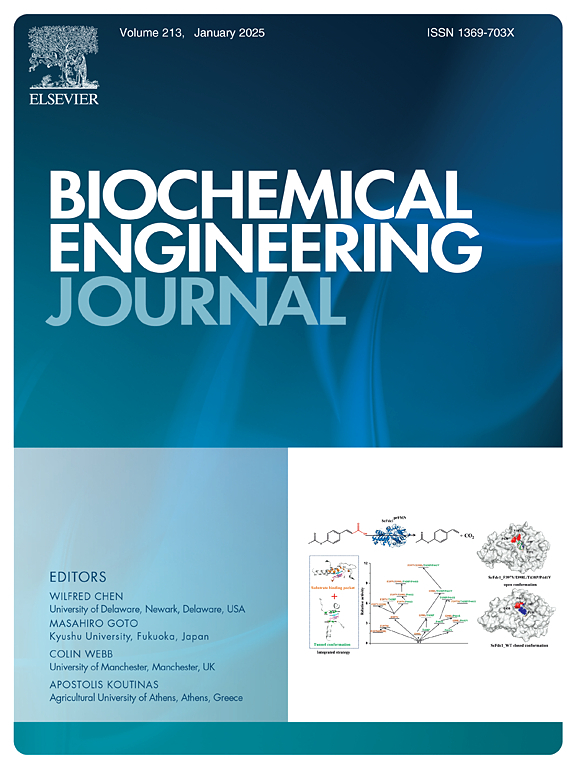Pros and cons of airlift and bubble column bioreactors: How internals improve performance
IF 3.7
3区 生物学
Q2 BIOTECHNOLOGY & APPLIED MICROBIOLOGY
引用次数: 0
Abstract
Gas fermentation is a promising technology of high commercial interest, particularly for capturing CO2 and CO from industrial off-gases to reduce greenhouse gas emissions and replace fossil fuels for bulk chemical production. Therefore, evaluating promising bioreactor settings ab initio is a crucial step. Whereas alternate configurations may be tested in laborious scale up studies, the procedure may be accelerated by in silico studies that accompany or even partially replace wet-lab work once the models are validated. In this context, the current study compares various pneumatically agitated reactor types – bubble column reactor (BCR), annulus- and center-rising internal-loop airlift reactor (AR-IL-ALR and CR-IL-ALR), and external-loop airlift reactor (EL-ALR) – to identify advantages and disadvantages for the given application based on computational fluid dynamics (CFD) models. Process performance is optimized by introducing internal structures to guide the flow. Despite a significant increase in the mass transfer coefficient () through internal modifications, the CR-IL-ALR still exhibited the poorest performance. The optimized AR-IL-ALR demonstrated good mixing and, after introducing an open-cone shaped internal in the head part and a conical bottom, superior mass transfer, achieving an enhancement over 10 % in the mass transfer coefficient to 315 1/h. This study thereby outlines the potential of internal structures for process improvement, as well as the value of a priori in silico design of reactor configurations.
气浮和气泡柱生物反应器的优缺点:内部结构如何提高性能
气体发酵是一项极具商业价值的技术,特别是从工业废气中捕获二氧化碳和一氧化碳,以减少温室气体排放,并取代化石燃料用于大宗化学品生产。因此,对有前景的生物反应器设置进行初始评估是至关重要的一步。虽然可以在费力的放大研究中测试替代配置,但在模型得到验证后,可以通过伴随甚至部分取代湿实验室工作的硅学研究来加速这一过程。在这种情况下,当前的研究比较了各种气动搅拌反应器类型--气泡塔反应器(BCR)、环形和中心上升内循环气动反应器(AR-IL-ALR 和 CR-IL-ALR)以及外循环气动反应器(EL-ALR)--根据计算流体动力学(CFD)模型确定特定应用的优缺点。通过引入内部结构来引导气流,从而优化工艺性能。尽管通过内部改造大大提高了传质系数(kLa),但 CR-IL-ALR 的性能仍然最差。优化后的 AR-IL-ALR 不仅混合效果良好,而且在头部引入开放式锥形内部结构和锥形底部后,传质效果更佳,传质系数提高了 10% 以上,达到 315 1/h。这项研究由此概述了内部结构在改进工艺方面的潜力,以及对反应器配置进行先验硅设计的价值。
本文章由计算机程序翻译,如有差异,请以英文原文为准。
求助全文
约1分钟内获得全文
求助全文
来源期刊

Biochemical Engineering Journal
工程技术-工程:化工
CiteScore
7.10
自引率
5.10%
发文量
380
审稿时长
34 days
期刊介绍:
The Biochemical Engineering Journal aims to promote progress in the crucial chemical engineering aspects of the development of biological processes associated with everything from raw materials preparation to product recovery relevant to industries as diverse as medical/healthcare, industrial biotechnology, and environmental biotechnology.
The Journal welcomes full length original research papers, short communications, and review papers* in the following research fields:
Biocatalysis (enzyme or microbial) and biotransformations, including immobilized biocatalyst preparation and kinetics
Biosensors and Biodevices including biofabrication and novel fuel cell development
Bioseparations including scale-up and protein refolding/renaturation
Environmental Bioengineering including bioconversion, bioremediation, and microbial fuel cells
Bioreactor Systems including characterization, optimization and scale-up
Bioresources and Biorefinery Engineering including biomass conversion, biofuels, bioenergy, and optimization
Industrial Biotechnology including specialty chemicals, platform chemicals and neutraceuticals
Biomaterials and Tissue Engineering including bioartificial organs, cell encapsulation, and controlled release
Cell Culture Engineering (plant, animal or insect cells) including viral vectors, monoclonal antibodies, recombinant proteins, vaccines, and secondary metabolites
Cell Therapies and Stem Cells including pluripotent, mesenchymal and hematopoietic stem cells; immunotherapies; tissue-specific differentiation; and cryopreservation
Metabolic Engineering, Systems and Synthetic Biology including OMICS, bioinformatics, in silico biology, and metabolic flux analysis
Protein Engineering including enzyme engineering and directed evolution.
 求助内容:
求助内容: 应助结果提醒方式:
应助结果提醒方式:


